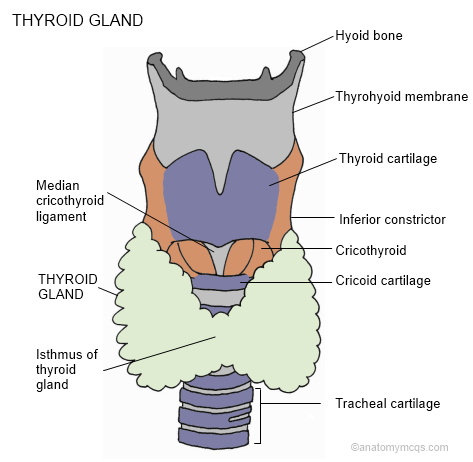Question #613
Considering the thyroid gland, which of the following statements is incorrect?
The thyroid gland is an endocrine organ located in the muscular triangle of the neck. Embryologically it forms from the back of the tongue at a point later known as the foramen caecum and descends inferiorly passing anterior to the hyoid bone before coming to lie at its final resting place at the inferior margin of the thyroid cartilage. The thyroglossal duct connects the foramen caecum to the thyroid gland. It is normally obliterated but may remain and even form a cyst.
The definitive thyroid gland has two lateral lobes connected by a central isthmus which overlies and is fixed to the cricoid cartilage. The lateral lobes extend as far down as the 6th tracheal ring.
Within the isthmus and both lobes are c-cells. These are derived from neural crest cells and migrate into the thyroid gland as part of the ultimobranchial body. C-cells are responsible for the production of calcitonin which decreases serum calcium levels.
The attachment to the tracheal and laryngeal cartilages means that the thyroid gland moves on swallowing, making thyroid masses easier to diagnose.
Blood supply is via the superior thyroid artery (from the external carotid artery) and the inferior thyroid artery (from the subclavian artery).
Venous drainage is via the superior and middle thyroid veins (into the internal jugular vein) and the inferior thyroid vein (into the left brachiocephalic vein).
Lymph drainage is to the deep cervical, pre-tracheal and para-tracheal lymph nodes.
The thyroid gland produces thyroxine in response to TSH (thyroid stimulating hormone) produced by the anterior pituitary. Thyroxine acts on cells throughout the body to increase the body’s basal metabolic rate.
